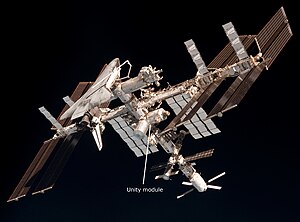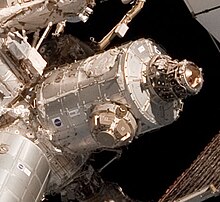Unity (ISS module)
 The Unity module as seen in December 1998 | |
| Module statistics | |
|---|---|
| COSPAR ID | 1998-069F |
| Launch date | 4 December 1998 |
| Launch vehicle | Space Shuttle Endeavour |
| Docked | 6 December 1998 |
| Mass | 11,612 kilograms (25,600 lb) |
| Length | 5.47 metres (17.9 ft) |
| Diameter | 4.57 metres (15.0 ft) |
| References: [1][2] | |

The Unity connecting module was the first U.S.-built component of the International Space Station. It is cylindrical in shape, with six berthing locations (forward, aft, port, starboard, zenith, and nadir) facilitating connections to other modules. Unity measures 4.57 metres (15.0 ft) in diameter, is 5.47 metres (17.9 ft) long, and was built for NASA by Boeing in a manufacturing facility at the Marshall Space Flight Center in Huntsville, Alabama. Sometimes referred to as Node 1, Unity was the first of the three connecting modules; the other two are Harmony and Tranquility.
Launch and initial berthing
Unity was carried into orbit as the primary cargo of the Space Shuttle Endeavour on STS-88, the first Space Shuttle mission dedicated to assembly of the station. On December 6, 1998, the STS-88 crew mated the aft berthing port of Unity with the forward hatch of the already orbiting Zarya module. (Zarya was a mixed Russian-US funded and Russian-built component launched earlier aboard a Russian Proton rocket from Baikonur, Kazakhstan.) This was the first connection made between two station modules.
Connecting modules and visiting vehicles
Unity has 2 axial, and 4 radial Common Berthing Mechanism (CBM) ports. In addition to connecting to the Zarya module, Unity connects to the U.S. Destiny Laboratory Module (added on STS-98), the Z1 truss (an early exterior framework for the station added on STS-92), the PMA-3 (also added on STS-92), and the Quest Joint Airlock (added on STS-104). In addition, the Leonardo and Raffaello Multi-Purpose Logistics Modules were each berthed to Unity on multiple missions. During STS-120 the Harmony connecting module was temporarily berthed to the port-side hatch of Unity. Tranquility, with its multi-windowed cupola, was attached to Unity's port side during the STS-130 mission, and PMM Leonardo was added to the nadir hatch during STS-133.
- Nadir
| Patch | Spacecraft | Docking | Undocking |
 |
STS-97 | 2 December 2000 19:59 UTC |
9 December 2000 19:13 UTC |
 |
STS-98 | 9 February 2001 16:51 UTC |
16 February 2001 14:05 UTC |
| Leonardo PMM, 2011-2015 | |||
 |
Cygnus CRS OA-4 | 9 December 2015 14:26 UTC |
19 February 2016 10:38 UTC |
 |
Cygnus CRS OA-6 | 26 March 2016 10:51 UTC |
14 June 2016 11:43 UTC |
| Cygnus CRS OA-5 | 25 August 2016 (planned) |
TBA | |
- Forward
| Patch | Spacecraft | Docking | Undocking |
 |
STS-96 | 27 May 1999 10:49:42 UTC |
6 June 1999 |
| STS-101 | 20 May 2000 04:30 UTC |
26 May 2000 | |
 |
STS-106 | 8 September 2000 12:45:47 UTC |
19 September 2000 |
 |
STS-92 | 11 October 2000 23:17:00 UTC |
24 October 2000 |
- Destiny, 2001–Present
- Aft
- Starboard
- Quest, 2001-Present
- Port
- Tranquility, 2010-Present
- Zenith
- Z1 truss, 2000-Present
Details

Essential space station resources such as fluids, environmental control and life support systems, electrical and data systems are routed through Unity to supply work and living areas of the station. More than 50,000 mechanical items, 216 lines to carry fluids and gases, and 121 internal and external electrical cables using six miles of wire were installed in the Unity node. Unity is made of aluminium.
Prior to its launch aboard Endeavour, conical Pressurized Mating Adapters (PMAs) were attached to the aft and forward berthing mechanisms of Unity. Unity and the two mating adapters together weighed about 25,600 pounds (11,600 kg). The adapters allow the docking systems used by the Space Shuttle and by Russian modules to attach to the node's hatches and berthing mechanisms. PMA-1 now permanently attaches Unity to Zarya, while PMA-2 provided a Shuttle docking port. Attached to the exterior of PMA-1 are computers, or multiplexer-demultiplexers (MDMs), which provided early command and control of Unity. Unity also is outfitted with an early communications system that allows data, voice and low data rate video with Mission Control Houston, to supplement Russian communications systems during the early station assembly activities. PMA-3 was attached to Unity's nadir berthing mechanism by the crew of STS-92.
Other nodes

The two remaining station connecting modules, or nodes, were built in Italy by Alenia Aerospazio, as part of an agreement between NASA and the European Space Agency (ESA). Harmony (formerly known as Node 2) and Tranquility (formerly known as Node 3) are slightly longer than Unity, measuring almost 6.4 meters (21 feet) long in total. In addition to their six berthing ports, each can hold eight International Standard Payload Racks (ISPRs). Unity, in comparison, holds just four ISPRs. ESA built Nodes 2 and 3 as partial payment for the launch aboard the Shuttle of the Columbus laboratory module, and other ESA equipment.
Footnotes
- ^ "NASA - NSSDC - Spacecraft - Details". Retrieved 8 November 2013.
- ^ "Unity Node". NASA. Retrieved 8 November 2013.
References
- NASA Facts: Unity Connecting Module: cornerstone for a Home in Orbit NASA, January 1999
- Expedition 15 - Tour of the Unity Node filmed in July 2007 by Clayton Anderson

